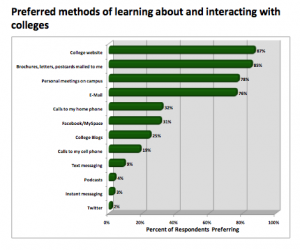I’m often made fun of when I refer to communications as “touches.”
“We’ll touch them once with a letter mailer, and follow it with a an email touch, and then….” If it’s the first time I’ve used this language in front of a client, I can often see a querulous look from my audience.
Why am I getting all touchy-feely?
People like to engage things by touching them. This is why the “mail moment,” experienced by 97 percent of American families each day, is a touch that is, and will forever be, so sensory driven.
We’ve found that touches, aka mailings or engagements, that provide the most opportunity for interactions are often dimensional mailings, i.e., boxes, tubes, slide rules, tear strips, scratch-offs, etc. (This is why Ed McMahon insisted that you punch out a little stamp and place it in a circle to select magazine subscriptions. Ed didn’t care, but American Family Publishing knew that if you interacted with their mailing your commitment rate would be higher.)
This tactile engagement, or touch, creates a memory in the brain that physically enforces the message with the movement. (Smart phone touch screens will take this soon to a whole new level, but that’s a later discussion.) This memory in the noggin carries additional commitment with the experience; thus, folks who engage are likely to move forward at greater rates with the desired behavior.
Boxes can work the same magic. Have you ever received a box in the mail that you haven’t opened? Dimensional magic, I tell you.
Why Folks Are Outside of the Box
If boxes are so great, yielding the open rates and tactile engagement that we want, then why are so many schools “outside of the box?” Why aren’t institutions sending boxes to families containing incredible recruitment pieces and campaigns? Why are colleges and universities being touch-me-nots?
There is already compelling evidence created by researchers such as the Longmire & Company that what families most desire in an initial communication is a well-done print piece or a well-done website. For success, both require a tactile engagement, or touch.

Students report preferring to learn and communicate with colleges via the school's website and through printed materials. (Data courtesy of Longmire & Company, "Report on the Use of Electronic Communications in College Recruiting," 2009.
Schools will say they can’t afford to send boxes. (I would argue that schools can’t afford not to send the most effective mailings.) But some institutions are getting serious about the use of tactile engagement and getting equally clever with their budgets and creative work. Consider the Visit Day campaign HA ThirtyOne is currently conducting for Albion College. The project centers around tactile engagement, featuring tear flaps on a print piece that are guaranteed to get opened.
The visit campaign allows for students to interact with video, register for one of two visit days, even invite a friend and share the experience on social media. Students (and parents) will remember this experience.
So here’s my challenge to you, those who want to go where others fear to traverse. Segment your audience. Use a test group with a dimensional mailing that offers an opportunity for touch, i.e., tactile engagement. It can be done safely and within a tight budget.
And remember…nobody likes a touch-me-not.
Categories
- Communication Flow
- Junior Campaigns
- Metrics
- Response Rates
- Segmented Campaigns
- Student Search Campaigns
- Uncategorized
- Visit Day Campaigns


2 Comments
cost of viagra
Don’t Be a Touch-Me-Not – H·A ThirtyOne
best viagra alternative
Don’t Be a Touch-Me-Not – H·A ThirtyOne
amoxycillin1st.com
Don’t Be a Touch-Me-Not – H·A ThirtyOne